Angkor Wat sunrise. That mystical, once-in-a-lifetime moment, when hundreds of tourists and camera aficionados gather in front of the most photographed Cambodian monument at 5 am, so that they could take that “unique” snapshot an hour later…
When the first rays of sunshine caress Angkor Wat and its silhouette dives into the reflection ponds in front of it, the morning magic stays an illusion. The reality hits you! Sunrise over Angkor Wat temple is not just one of those things to see before you die. It is, even more precise, a place to die before you see! Armed with selfie sticks, tripods, and elbows at least, these eager tourists claim their territory with a somewhat ferocious passion.
As if they are all hunting a vampire that will turn to dust at dawn, Angkor Wat tourists are fighting for their instalife
As if they are all hunting a vampire that will turn to dust at dawn, Angkor Wat tourists are fighting for their instalife. The largest religious monument on the planet will become a hashtag as the day progresses, with over 1,4 million #angkorwat images on Instagram.
In this blog post, discover if Angkor Wat sunrise is worth it! Find out what is the best way to see the temple complex, how many days to reserve for this iconic Khmer landmark, as well as where to stay when visiting Angkor Wat!
Bur first some essential Angkor Wat information!
Angkor Wat quick facts
What is Angkor Wat?
Angkor Wat is located in northwestern Cambodia, near the town of Siem Reap. It is the largest temple of the Angkor complex, one of the most important archeological sites in Southeast Asia. Angkor (meaning ‘city’) was the capital city of the Khmer Kingdom from the 9th till the 15th century. It spread over 400 square kilometers!
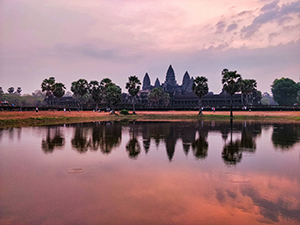
Angkor Wat is the masterpiece of Khmer religious architecture. Surrounded by a 200-meter-wide moat and the rectangular wall, the central Angkor temple has three floors with richly decorated galleries, ending up with five towers in the shape of lotus buds. It is a symbolic representation of ocean-surrounded Mount Meru, the mythical home of Hindu gods beyond the Himalayas.
As a source of national pride, Angkor Wat appears on the Cambodian flag and banknotes.
It is also a major touristic product. Angkor Wat is for Cambodia what is Machu Picchu for Peru, pyramids for Egypt, Taj Mahal for India, Borobudur for Indonesia, Bagan for Myanmar, My Son for Vietnam, or Ayutthaya for Thailand.
In 1992, Angkor Archeological Park was declared a UNESCO World Heritage site.
When was Angkor Wat built?
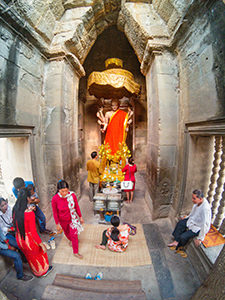
The Khmer Empire built Angkor Wat temple in the early 12th century. King Suryavarman II ordered the construction of the Hindu temple dedicated to Vishnu, the state temple of the Khmer capital.
The legend says that a divine architect constructed Angkor Wat in one night. Those who did not believe that the technology of those times could build such marvel, even introduced an ancient alien intervention as an explanation.
However, the truth is that building Angkor Wat was just hard work. It required three decades, 300.000 workers, and 6.000 elephants!
Why does Angkor Wat face west?
While Hindu temples typically face east, Angkor Wat’s orientation defies the norm. One explanation says this is because of Vishnu, who is often associated with the west. The other idea associates the west with the sunset/death. It follows the theory that the mighty king wanted to use Angkor Wat as his mausoleum.
Why was Angkor Wat abandoned, and when?
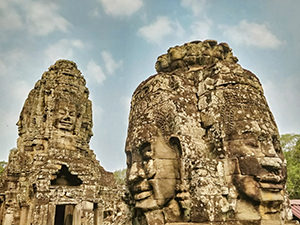
In 1177, during the reign of King Jayavarman VII, Cham people sacked Angkor. It was thought Hindu gods deserted it, so the kingdom built the new capital of Angkor Thom nearby. They dedicated all temples to Buddhism at that moment.
In the early 15th century, Ayutthaya kingdom and natural disasters hit Angkor. Climate change, intense monsoon rains and devastating floods started the final collapse. People abandoned Angkor, and the jungle took over. The capital of the Khmer kingdom moved to Phnom Penh.
Water was essential for the development of Angkor, as National Geographic suggests. Learn more about Angkor Wat in this Youtube video!
Angkor Wat discovery
A Portuguese friar Antonio da Madelena was one of the first western people who visited Angkor Wat. In 1589, he said it was like no other building in the world: “It has towers and decoration and all the refinements which the human genius can conceive of.”
The credit for the discovery of “the lost city of Angkor” goes to the French naturalist Henri Mouhot. He visited the area in 1860, and his travel memoirs encouraged many archeologists to start digging the secrets of the ancient civilization.
Cambodian temple rush and overtourism
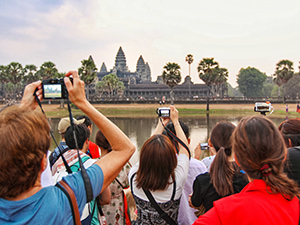
In the span of the last 25 years, Angkor Wat became the goose that lays the golden eggs in the Cambodian tourism basket. The site that was visited by several thousand visitors in the 1990s, reached 2,5 million foreign tourists in 2018!
In 2019, the tourist numbers in Siem Reap, the main gateway to Angkor Wat, started to decline. From January till November, they sold a bit less than 2 million Angkor Wat passes. That is a 14 percent drop when we compare it to the same period last year! The tourism ministry explains the decrease with the smaller economic power of middle-class Chinese tourists, while wealthier ones shifted to Phnom Penh and Sihanoukville as destinations.
Even with a formal number drop, a typical visitor will not experience the lesser pressure on the biggest attraction of Angkor Archeological Park – Angkor Wat at sunrise. All Angkor tours present visiting Angkor Wat temple as a must. Angkor Wat sunrise is mystified as an unmissable part of experiencing the most famous Cambodian temple.
The blinding golden eggs
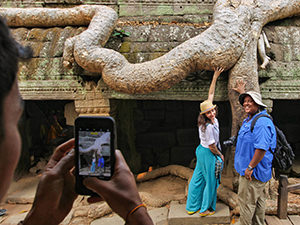
When I first visited Cambodia in 2017, I toured the country for a month. My decision to skip Angkor Wat someone could see as shocking. The whole tourism of Cambodia is often perceived through the idea that there is nothing else of tourist interest besides Angkor Wat and the Killing Fields. In my month-long exploration, I’ve learned that Cambodia is a victim of its own promotion. The excellent tourism potential in underrated provinces doesn’t get the same chance as Angkor Wat tourism!
The result is that Cambodian tour arrangements often combine with visits to Vietnam or Thailand. Angkor Wat blessing becomes damnation. It is the only Cambodian touristic site with real promotional power. Therefore, Angkor Wat sunrise overshadows all other aurora experiences of Cambodia!
Never put all your eggs in one basket, especially when they are made of gold!
Angkor Wat may be one of the wonders of the world. But if one puts all eggs in one basket, no matter how gold these eggs are, there is no space for wondering why the rest of the yard is practically blinded.
On my return visit to Cambodia in 2019, I decided to check what this overtourism buzz is all about finally!
Cycling to Angkor Wat for sunrise
It was 4 am when I left Sleep Pod Hostel, the base for exploring Angkor Wat in my first days. I rented a bicycle for 3 dollars (2,7 Euros), grabbed a simple breakfast package at the front desk, and hit the dark roads of Siem Reap.
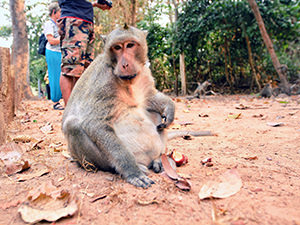
Riding a bike through the quiet town was a pleasant experience. The temperatures were far more pleasant than at noon, of course, and distances seemed shorter. There was no considerable traffic, only tuk tuks slowly picking up half-asleep tourists for temple hopping adventures.
Cycling to Angkor Wat for sunrise was easy, straightforward, and almost meditative. Crickets woke-up first. Later, the birds joined.
I bought my Angkor Wat ticket the day before, so I headed straight to ‘Rome’. At the check-point, an officer punctuated a hole in the admission ticket and offered tour guide services on the side. I proceeded alone. Yes, it is possible to visit Angkor Wat without a guide!
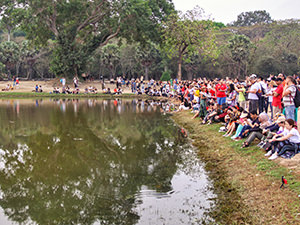
At the destination, the temple rush was already in full swing. Breakfasts, souvenirs, tours… The day might have been young, but the Cambodian market spirit was fully awake!
With a decent mass of people turning up, the first-time visitor could have easily mistaken the moat or the nearby pond for the places where those iconic Angkor Wat photographs came to life. If they didn’t check your Angkor Wat ticket yet (and that happens on the bridge), you probably arrived at the wrong spot!
One needed to cross the moat via the floating bridge (the original stone crossing was under renovation), enter through the outer wall, and follow the avenue adorned with naga-style balustrades to the central complex. This path would pass right in between the two small buildings called the libraries. And then, two pools of water, the favorite destination of the early risers.
Especially when we visit religious sites, we can easily overdo it with photography. Check out how I got in real trouble with the Chinese tourists when visiting the African Jerusalem!
Fight for territory
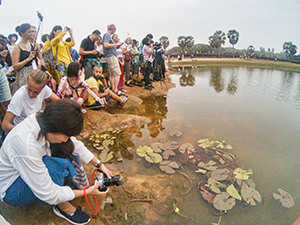
The image of hordes of tourists squeezing out the last bit of free space around the reflection ponds in front of Angkor Wat was probably the most potent illustration of overtourism at this Cambodian monument.
With sleep crust still in their eyes, and hands full of technical equipment, these sleepy visitors were manspreading, irrelevant to their gender or age. In the darkness before sunrise, they instinctively knew that more space guaranteed more flexibility in catching Angkor Wat’s iconic reflection in what was essentially – ditch water.
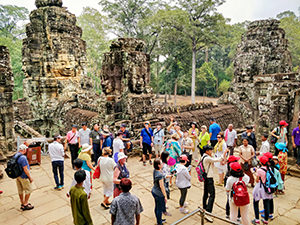
“Well, excuse me! No, you can’t sit in front of me!”, one lady raised her voice, introducing the territorial theory that one does not occupy only the space one is standing on. The young Frenchman’s face did not show much appreciation for the lady’s ladyness. She quickly approached the conflict with the promise of a future compromise: “Don’t worry! We will adjust!”
Once the Sun was up, adjustment or compromise disappeared from the memory. It was the power of the muscles that would decide the winner of the photo of the day.
People are willing to go far for Instagram! Check Pipeaway’s viral article on Indonesian girls who crossed the line to take a selfie!
Angkor Wat sunrise best spot
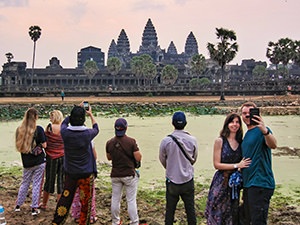
Various online resources are claiming that the northern reflection pond is the best Angkor Wat sunrise spot. Paradoxically, when I visited the temple, the sunrise crowd gathered in much more significant numbers around the southern reflection pond.
Do not believe the ultimate advice on how to catch the best sunrise at Angkor Wat! Do not follow blindly the tips on where to stand! The truth is that the temple is touristically exploited throughout the year, and the Sun will not be rising at the same spot in December and June. Also, levels of water in two pools may vary, and this will significantly affect your photograph! When I visited Angkor Wat, the “perfect” northern pond was full of lotuses, which were preventing you from taking the iconic reflection image.
I would advise you to pass by the temple on one of the mornings before your planned shooting day. That way, you could comprehend the momentary Sun’s orbit concerning the actual Angkor Wat architecture, as well as check the situation with the ponds flora. This way, you could decide for the best position in the particular moment of your visit by yourself!
Is Angkor Wat better at sunrise or sunset?
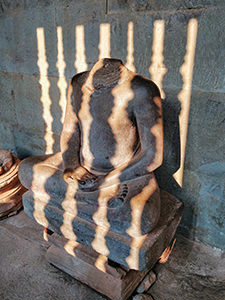
In the era of social media, it became fashionable to reenact famous images photographed before us. The social pressure relies on the premise that anyone can and has to deliver a professional level of photography.
Under these expectations, the idea of the golden hour was pushed into the foreground. In the first hour after sunrise, and the first hour before sunset, the light is much softer than in the middle of the day. To those who want to level up their photography, this provides the magic that no Instagram filter can mimic. Suddenly, we all became pros!
Angkor Wat sunrise craze is definitely a part of this phenomenon. Even if it sometimes doesn’t make sense at all. Especially in the times of the agricultural burning season (January-May), when even the Sun cannot penetrate the smoke curtain, and Angkor Wat air quality significantly drops too.
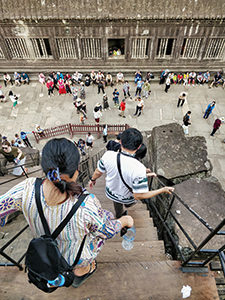
Still, hope dies last, and tourists gather at reflection ponds expecting that Angkor Wat photography archives will remember this day as the day of the ideal sunrise.
If you cannot handle sunrise crowd engaging in a stampede hunt for the perfect photo moment, I’d suggest visiting Angkor Wat at sunset instead. The whole day of temple hopping exhausts people, so they do not behave as hysterically at later hours!
Still, at any moment of the day, there will be people! Angkor Wat without crowds is an oxymoron.
Selfie rush
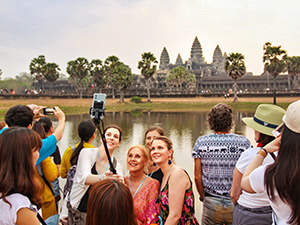
There is still selfie rush throughout the day, so prepare yourself! You will never see western tourists desecrating churches in Europe on the same level they are switching off their brains when visiting Asian temples! Girls tossing their hair in the tombs, influencers climbing to forbidden areas, monk-hunters pulling anyone in orange robe in front of their lens… Instafame comes in many forms!
On one late-afternoon visit to Angkor Wat, a young man approached me. He asked if I could take a photo of him in front of the temple.
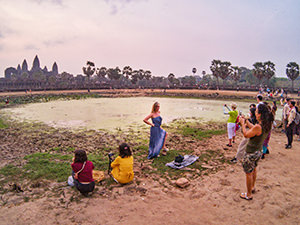
When I saw ridiculous poses other visitors were taking in front of the largest religious monument in the world, I instinctively reacted with disgust. I even mumbled something about psychiatric disorder. To my surprise, I did not offend him at all and he still insisted I take his camera.
I took a photo and thought that was it. But then he wanted one with his palms joined in sampeah gesture! Then another one with his arms spread out wide! Then he turned his back and wanted the photograph of his back in front of the temple! I could only roll my eyes and conclude that influencers were influential indeed!
How many days do you need for Angkor Wat?
First of all, have in mind that Angkor Wat is often confused with the whole of Angkor Archeological Park. There are hundreds of Angkor remains worth visiting, and they are not always close to each other! Only your personal preferences and how quickly the temple fatigue would hit you, should determine the number of days you want to spend at this cultural site.
It is essential to know that Angkor Wat pass is not transferrable and includes the photograph of the visitor.
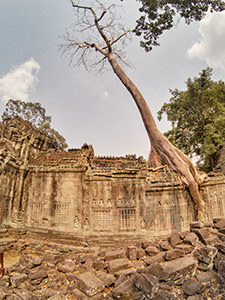
If you only wanted to visit Angkor Wat, the most famous temple of all, a one-day visit would certainly suffice. You would even be able to add a few more temples in your Angkor itinerary! Angkor Wat ticket for one day would cost 37 USD (33 Euros).
If you wished to see more of Angkor, be flexible with your time, and minimize the stress of the visit, you should choose the 3-days pass. The entrance fee for three days would be 63 USD (57 Euros), and it would be valid for ten days.
The most passionate archeology lovers could consider purchasing a seven-day Angkor pass. In that case, the admission fee would be 72 USD (65 Euros). One could use this ticket in a period of a month.
Multiple day tickets do not need to be used on consecutive days.
The Angkor Ticket Office is located on Road 60. It is the only place where one can purchase the entrance tickets. You can find more information on Angkor Wat official website.
The best way to see Angkor Wat and other Khmer temples
When taking into account the vastness of the site and the context of overtourism, I believe that the 3-day pass provides the best frame for visiting Angkor Wat and other relevant places of this famous Khmer archeological site. It will save the energy you would waste on a one-day temple hopping and give enough time to adjust your Angkor Wat itinerary according to your personal preferences.
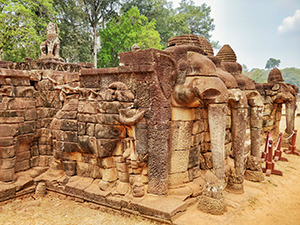
There are two things I would recommend doing in the days before the planned visit to Angkor. One is purchasing your ticket, as its validity lasts ten days anyway. The second one is visiting the Angkor National Museum. This archeological museum in Siem Reap is a great quick introduction course to understanding the art and culture of Khmer civilization! The entrance to the museum costs 11 USD (10 Euros).
Another useful resource I used was the “Ancient Angkor” guidebook by Claude Jacques. Even if my copy of the book was the revised edition from 2003, which meant some of the info was outdated, it still provided an educational read when I needed to take a break at each site.
Proposed Angkor itinerary
Day 1 – Exploring Central Angkor
Morning at Angkor Wat temple
Start your temple adventure with Angkor Wat sunrise! Stay enough to take some lovely photographs, but don’t explore the central temple grounds just yet! You will come back to this place in the afternoon!
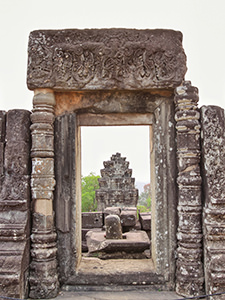
Head to Phnom Bakheng, the state temple of Yasodharapura, the first Angkor capital, in the late 9th century! The pyramid of ascending square terraces might be in poor condition, but one can still see linga sculptures in a couple of sanctuaries. Enjoy your breakfast at the summit and then descend over the “elephant path”! In 2020, elephant rides are scheduled to be banned altogether, so their serpentine road will remain just a hiking path.
At the foot of the hill, take some photographs on Baksei Chamkrong, the only pyramid temple at Angkor that wasn’t a state temple! Spend some time observing the monkey troupes playing around the temple! Some of these macaque monkeys are severely obese, so don’t participate in feeding them!
Face-towers, ponds, and elephants of Angkor Thom
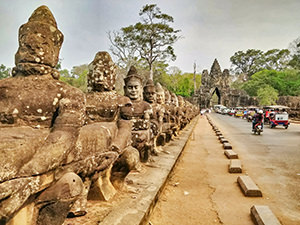
Spend the rest of your morning and afternoon in Angkor Thom, the last capital of the Khmer Empire! You will enter it through its southern gate, adorned with sculptures of Devas and Asuras, the traditional divine enemies in the Hindu mythology, and the stars of the Churning of the Ocean of Milk, a reoccurring storyline in Khmer temples.
As announced by the face-towers at the city gates, a center of the Angkor Thom mini-universe is Bayon temple. This is one of the most popular tourist sites after Angkor Wat. Prepare yourself for throngs of tourists engaging in a crazy competition of taking profile-selfies! The temple’s architecture resembles a stone mountain made of face-towers! While selfie freaks are trying to align their nose with a nose of some sculpture, try to count the towers and faces! There is a constant dispute on their impressive number!
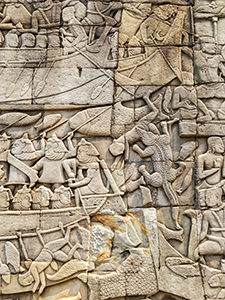
Besides being known as a temple with faces, Bayon also features unique bas-reliefs narrating Khmer’s daily life and history. See the fight between the Khmers and the Chams, find a tiger or crocodiles eating men, a woman giving birth, market scenes, cock and boar fights, wrestlers, and even circus performers doing balancing tricks or foot juggling!
Next, visit Bapuon, a massive temple-mountain which served as a state temple of Yasodharapura, and Phimeanakas, the state temple of Suryavarman I! In their vicinity, there are large ponds where local kids come for a refreshing swim on a hot day.
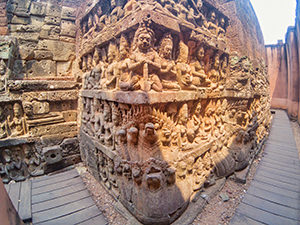
Elephant Terrace and Leper King Terrace both deserve a short visit. The Terrace of the Elephants is famous for carvings depicting these gorgeous animals in hunting scenes, as well as three-headed elephants, garudas and lion-headed figures “supporting” the wall. The Terrace of the Leper King offers hidden reliefs of deities on the 6-meter walls in the narrow zig-zag trench.
Haggle for your lunch
If you can still stand on your feet, finish your Angkor Thom exploration with a quick visit to Preah Palilay and Preah Pithu sanctuaries! Alternatively, head for lunch at one of the restaurants nearby! It will not be hard to find them. Their scouts will spot you instead! Do not just surrender to the first lady in a hat approaching you; prices are overblown! It’s good to know you can haggle, and pay your chicken amok four instead of 8 dollars, and your coconut one instead of 2 dollars!
Angkor Wat sunset
End your first day with the Angkor Wat tour! Start at the west entrance gopura where you can see the eight-armed statue of Vishnu, to whom the temple was initially dedicated.
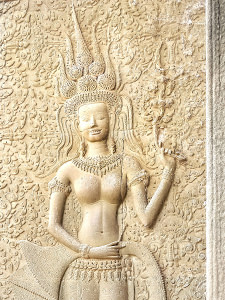
There are almost 2000 apsaras, the dancing female spirits, depicted in Angkor Wat! One of them is unique, smiling with her teeth showing! Find it on the inner wall, just next to the main Angkor Wat entrance!
Follow lions and nagas, and head inside Angkor Wat! Explore the courtyards and galleries, see the balusters imitating wood, Buddha statues and depictions of hell, the extraordinary bas relief showing real and mythological battles… Angkor Wat carvings are simply remarkable!
For the uppermost level of Angkor Wat, there will probably be a long queue in front of the steep stairs. Do not wait for the last minutes of the daylight if you want to see the temple grounds from above!
Now that you have witnessed the fine details and proportions of this architectural masterpiece, you can surrender to the atmosphere of the dying day. Enjoy Angkor Wat temple washed in sunset colors!
If you wanted to see Angkor Wat from above, you could also take a balloon ride or fly out with your drone. However, drone permits could raise your expenses to 1000 Euros! Maybe it is easier to enjoy Angkor Wat aerial view provided by the filmmaker Max Seigal!
https://youtu.be/XCpAWH_1ttc
Day 2 – Exploring Eastern and Northeastern Angkor
Lake and jungle covering secrets
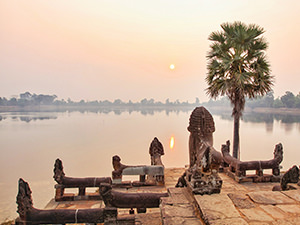
Start your day with a radically different alternative to Angkor Wat sunrise! At Srah Srang (Srassrang), you will find the tranquil experience that most Angkor visitors miss. More popular among dogs than humans, this large rectangular lake is a giant mirror in the morning hours, and it can make you meditate! Sit on the sandstone terrace decorated with lions and nagas, and imagine Khmer kings dipping in this royal bath measuring 700 by 350 meters!
After the sunrise meditation or even yoga at the banks of the lake, you have time to grab breakfast at some local eateries near Ta Prohm. Famous as a setting for “Tomb Raider” and “Indiana Jones and the Temple of Doom”, this Angkor temple opens at 7:30 am and crowds conquer it later in the day, so it’s better to visit it while other tourists attack Bayon.
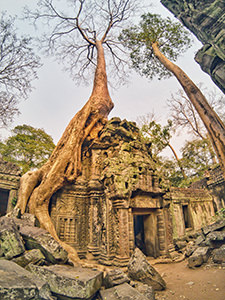
Ta Prohm’s most famous feature are tree roots growing over the ruins. Entangled in strangler figs and silk-cotton trees, this site is a real jungle temple!
Most of Angkor looked like that when Henri Mouhot discovered it in the 19th century. Jungle growth was the one to blame for the collapse of many temples, and Ta Prohm was chosen to stay in its “natural state”, maintained only enough to prevent further collapse.
Enjoy your Lara Croft / Angelina Jolie and Indiana Jones / Harrison Ford moment in this Cambodian temple overgrown by nature!
Archeology freaks should stay a little longer and look for the small carving on the wall resembling a dinosaur – actually, a stegosaurus! Of course, Cambodians have never seen these ancient animals, so can you figure out what does the carving represent?
Sacred homes of deities
After Ta Prohm, you can visit another temple of Jayavarman VII nearby hidden behind the walls guarded by face-towers! In enclosures of Banteay Kdei, the smaller version of Ta Prohm, find the seated Buddha or beautiful examples of devatas, Hindu deities carved in the walls.
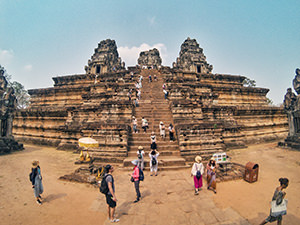
On your way to the north, visit Ta Keo! This giant temple-mountain was built entirely of sandstone. As in the case of Angkor Wat, the five towers on the top of the pyramid represent the peaks of the sacred Mount Meru. Watch out when climbing the steep stairs that even the high priests refused to use! Yogisvara Pandita considered himself unworthy of the upper terrace!
On the Victory Way, just next to Siem Reap River, take a short stop at Spean Thma, which served as a bridge before the river was diverted! It is made of reused stones from earlier temples. Further up the road, two temples in Angkor Wat style are worthy of taking a quick look – Thommanon and Chau Say Tevoda. Find some excellent devata carvings in the first one!
Temples as hospitals and universities
Preah Khan is another site hugged by trees, but with fewer tourist swarms than Ta Prohm. It served as a Buddhist university with over 1000 teachers! On this site, you can find an atypical two-storied building standing on round columns!
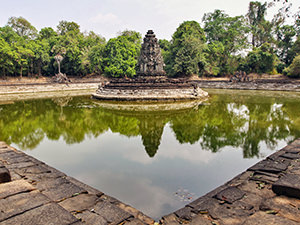
Just east of Preah Khan, in the middle of the large lake (3,5 x 1 kilometer), there is Neak Pean, an artificial island with five smaller ponds. The central pond has a circular island with a Buddhist temple. In the 12th century, the site served as one of many hospitals built by Jayavarman VII. Khmer people believed the water had healing properties, just like the mythical lake Anavatapta in the Himalayas.
Day 3 – Roluos and Banteay Srei
Keep the third day of your 3-day Angkor pass for the sites further afield! If you only want to go to the Roluos group, tuk-tuk will be fine. If you’re going to include Banteay Srei, rent a car!
Thirteen kilometers east of Siem Reap, Roluos temples are dated to the late 9th century.
Indravarman I built Preah Ko as the first temple in the capital city of Hariharalaya. Its six brick towers stand in front of the three kneeling bulls, hence another name to the temple – The Sacred Bull.
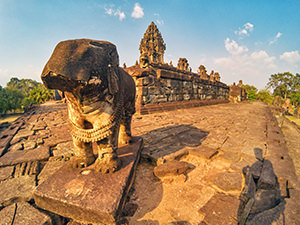
Bakong was the first Khmer temple-mountain. This five-tiered pyramid guarded by elephant statues was the state temple and dedicated to Shiva.
North of Siem Reap, some 35 kilometers, Banteay Srei is often described as the “Jewel of Khmer art”. The decoration at this small temple is rich, so reserve at least an hour to explore its beautiful carvings in pink sandstone. Andre Malraux, French minister of culture, couldn’t resist this beauty in his youth, so he tried to steal four apsaras in 1923!
Another 15 kilometers to the north, Kbal Spean is an archeological site where the artists carved the images of the gods directly into the river bed! There are also hundreds of lingas. The best time to visit is the end of the wet season when carvings are not entirely submerged.
What to wear when visiting Angkor temples?
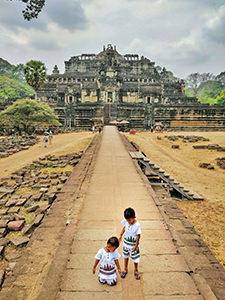
Even if the behavior of some tourists suggests that they see Angkor Wat and other Angkor temples as just Instagrammable piles of rocks, Cambodians consider these grounds as sacred by Cambodians and we should treat them with respect. That includes following the dress code!
The rule of thumb says you should not visit temples if your shoulders and knees are not covered. Capri pants and T-shirts are fine!
If you want to be less hot when cycling around Angkor, you can always bring temple-appropriate clothes with you and put them on before entering the temple grounds. This way, you will obey Angkor Wat clothing rules, but also enjoy the bike ride in less formal attire.
When to travel to Angkor Wat?
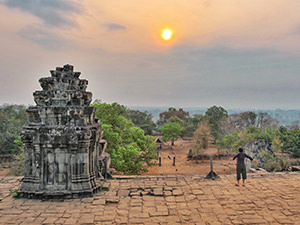
Angkor temples are open every day, all year long. Angkor Wat, Srassrang, Phnom Bakheng and Pre Rup open their door at 5 am. All other temples start working at 7:30 am. Closing time is 5:30 pm, except for Phnom Bakheng and Pre Rup, which close at 7 pm.
The best time of the year to visit Angkor Wat and the rest of Angkor park is the dry season. The most pleasant weather is between November and March, but this is also a popular period among tourists. If you want to avoid the overtourism stress as a side-effect of Angkor Wat travel, shoot at the shoulder season!
Where to stay when visiting Angkor Wat?
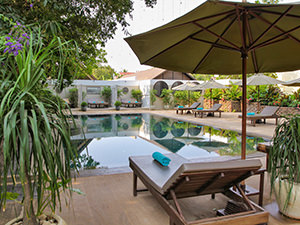
Getting to Angkor Wat temple is a piece of cake if staying in Siem Reap. The accommodation of your preference will easily organize tuk-tuk, car, or bike rentals!
If you just started planning your Angkor Wat trip, it is good to know that we have already written about extraordinary Siem Reap hotels, such as Jaya House RiverPark or Rambutan Resort.
In this article, I draw your attention to some new answers to the ultimate question: where to stay in Siem Reap?
Heritage Suites Hotel – the luxurious sanctuary
Price per night: 191-311 Euros (Suite with private pool)
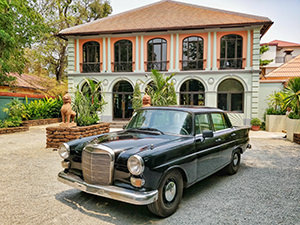
Heritage Suites Hotel was one of Cambodia’s first luxury boutique hotels. Located next to Wat Polanka, Siem Reap’s oldest pagoda, and only a 15-minute ride away from Angkor Wat, this five-star hotel was a perfect base to explore Khmer temples with no stress.
In 2018, the property went through a major refurbishment. The new look brought European-style luxury but still kept the authentically Khmer hospitality. They modernized the hotel but continued picking up guests at Siem Reap airport in charming vintage Mercedes from 1962.
The art of wellbeing
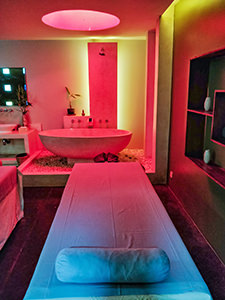
Heritage Suites put a strong focus on health. I’m not saying this just because they were very kind when I checked-in! After I arrived with severe stomach problems, the hotel staff immediately delivered a special tea and fruit basket to my room, to speed up my recovery. However, there was much more to their care than just being thoughtful.
Heritage Spa by Bodia was providing a wide range of wellness experiences! Their professional and relaxing massage, using 100 % natural local products, restored my balance once I got on my feet again!
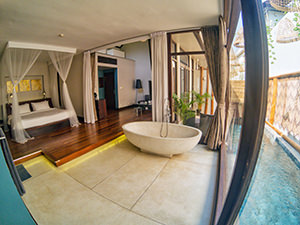
One could surrender to decadent but healthy rituals in one’s room too! Heritage Suites Hotel was the only Siem Reap hotel that had private steam baths in every suite! My Colonial Suite (named Bird of Paradise) also had a private outdoor plunge pool where one could jump for immediate cooling after some good sauna sweat.
There was also a complimentary mini-bar with beer, Coke, and water. Alternatively, one could enjoy some Arabica espresso or premium tea – on the small terrace or at the seating area inside.
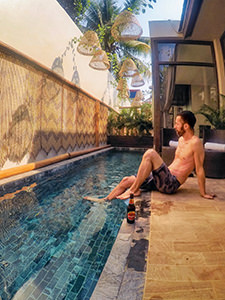
With floor-to-ceiling windows, the 80-square-meter room felt even more spacious. You could store your luggage in the walk-in closet, out of public view. King size bed was a treat to sleep in. The exposed large stone bathtub was inviting for even more indulging!
Committed to social responsibility, Heritage Suites Hotel made its amenities from organic and fully recyclable materials. Also, one needed to request them, which adhered to the best practices of eco-hotels.
Besides private pools and Jacuzzis, Heritage Suites also had a central swimming pool, with chemically not treated saltwater. It was available 24 hours a day!
Eating as an experience
If you swapped the day at the pool with the temple hopping day (and hotel’s in-house tour agency offered some off-the-beaten-path adventures!), you could at least count on diving into the gastronomic delights when you returned! The restaurant delivered Khmer and western specialties in the pleasant grand lobby; a lighter snack menu was available by the central pool.
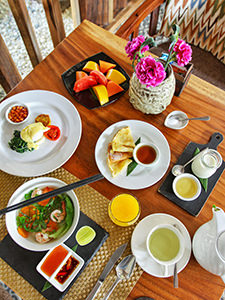
Breakfast was generous in both options and quantities (highlights for me included Khmer noodle soup with shrimps, sticky rice with sesame and palm sugar, and a vegan section of the menu). I thought that dinner dishes could balance better the high artistic plate presentation with the substantiality of the meal.
I especially applauded the hotel’s dedication to broadening up the dining experiences in Siem Reap. Dinner in the Dark was one of those intriguing events that made you focus on food and nothing else, almost like a gastronomic meditation!
Switching the nostalgia on
Member of Secret Retreats, Heritage Suites Hotel delivered nostalgia for times when switching off was much more natural, times when technology was not distracting us.
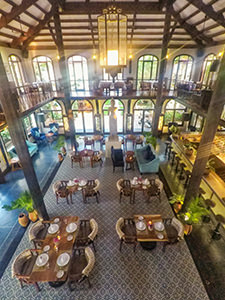
In the spirit of electronic-free rooms, TV entertainment at this hotel was made available only on request.
Socializing at the large pewter bar while sipping a glass of martini or just hanging by the pool with Angkor beer in hand was a preferred version of colonial retreat Heritage wanted to promote.
Providing their guests with an always-available personal assistant and thoughtful turndown service, or expressing welcome with a small gift from local artisans, Heritage Suites Hotel was much more than just another boutique hotel. It was a window into the past when human touch meant much more than the price tag.
If you are considering staying here, check the best prices at the Heritage Suites Hotel on Booking.com!
Sleep Pod Hostel – affordable nap nook
Price per night: 3-22 Euros
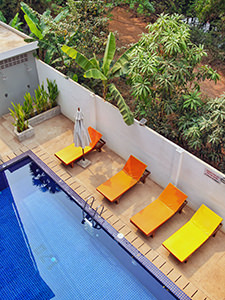
Siem Reap provided accommodation for every pocket. So if you wanted to find something more economical, but still decent enough, there was a solution for that as well!
Sleep Pod Hostel opened in 2018, just south of the town center. It was not the closest accommodation to Angkor Wat, but with the money you would’ve saved on the room price, you could’ve easily rented a tuk-tuk for a day!
Space for rest
Rooms at Sleep Pod Hostel came in standard dormitory form, with bunk beds fitting four or six persons (and one of them was reserved for female visitors only). On the other hand, there was also an option of a superior double room!
Even if dorms felt spacious enough, I had the privilege to stay in a private room, and had all the space in the world! The room size was 28 square meters! Quite a lot for a hostel! If I wanted to, I could have easily trained yoga, maybe even group acrobatics, in this room!
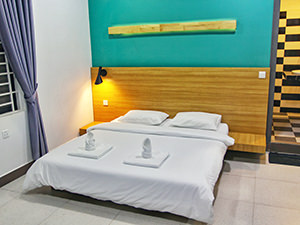
The room had a TV, small fridge, kettle, large bed, and a working desk. The private bathroom came with a shower, and they provided the towels free of charge. If one wanted to wash some clothes, that was possible by purchasing a token for the machine. An excellent thing for longterm-traveling backpackers!
Any downside? There’s some space for improving the quality of housekeeping, as some guests might object to spider webs on the room walls. A technical disadvantage of the location was that there was no particularly lovely view from the room window. Metal bars on the second floor certainly didn’t help that either. But if one just needed the place to rest in an air-conditioned space, Sleep Pod Hostel delivered.
Bean bags and scrambled eggs
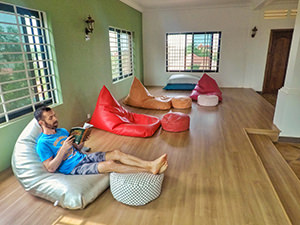
In the common areas of the hostel, there were bean bags to rest on or read a book. One could play board games or guitar in the lobby. There was also a small swimming pool with a sundeck. Pools are always an excellent addition to hostel-level accommodation! Being able to take a refreshing dip at the end of a long and tiring day was an opportunity that most guests didn’t consider skipping.
One could order simple brekkie and eat it on the terrace, adjoining the pool. Whether you chose the standard continental breakfast option with scrambled eggs, bacon, tomatoes, sausage, and toast, or the local favorite beef lok lak, the restaurant provided the elemental energy for the temple exploring day. For early risers, a lunch package was available!
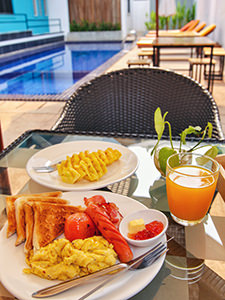
If local specialties increased your interest in Khmer cuisine, Sleep Pod Hostel had a cooking class in the offer. Also, if you wanted to improve the technique of your magic hands, massage class was available!
The name of Sleep Pod Hostel suggested it was just a place to crash for the night. However, it showed the potential and ambition to offer more. The attention to detail was already seen in blue color, branding everything from the walls and room keys to staff T-shirts. At the moment, it is undoubtedly an affordable nap nook, and with additional care, it could firm its position as one of Siem Reap’s most excellent premium quality hostels!
If you are considering staying here, check the best prices at Sleep Pod Hostel on Booking.com!
Did you like this article about Angkor Wat sunrise? Pin it for later!
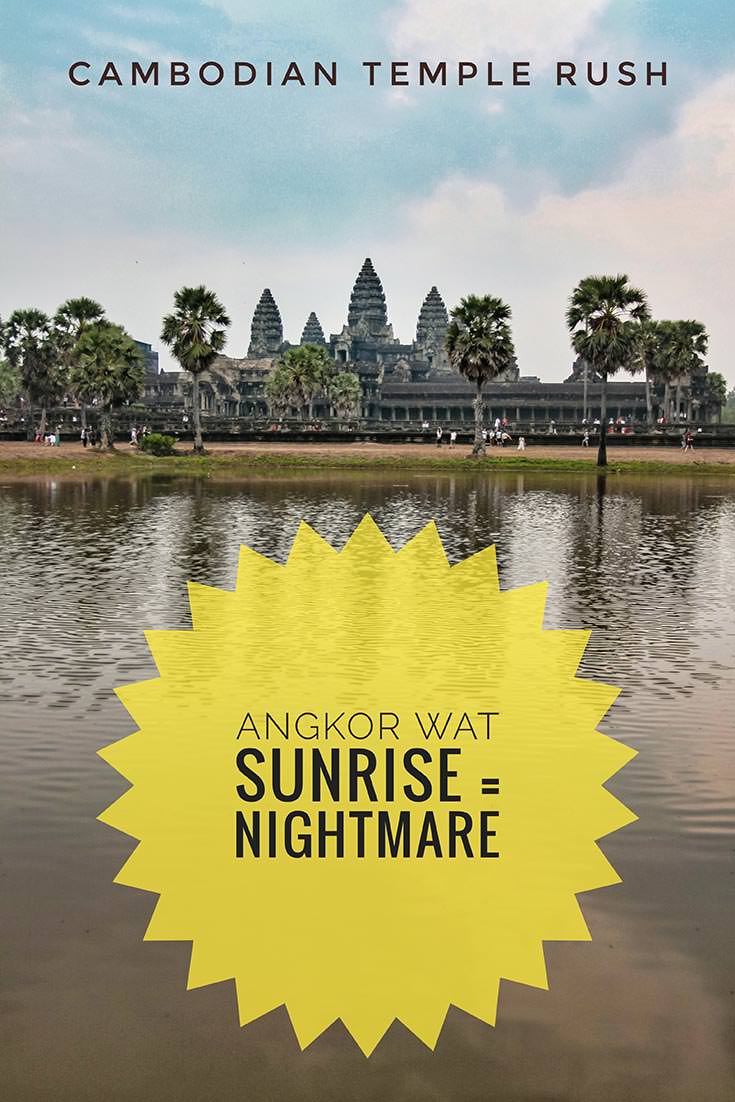
Disclosure: My stay at the Heritage Suites Hotel, as well as Sleep Pod Hostel, was complimentary, but all opinions are my own. Thanks to HotelierIQ, for facilitating the stay at Heritage Suites Hotel! Also, this post contains affiliate links, which means if you click on them and make a purchase, Pipeaway might make a small commission, at no additional cost to you. Thank you for supporting our work!

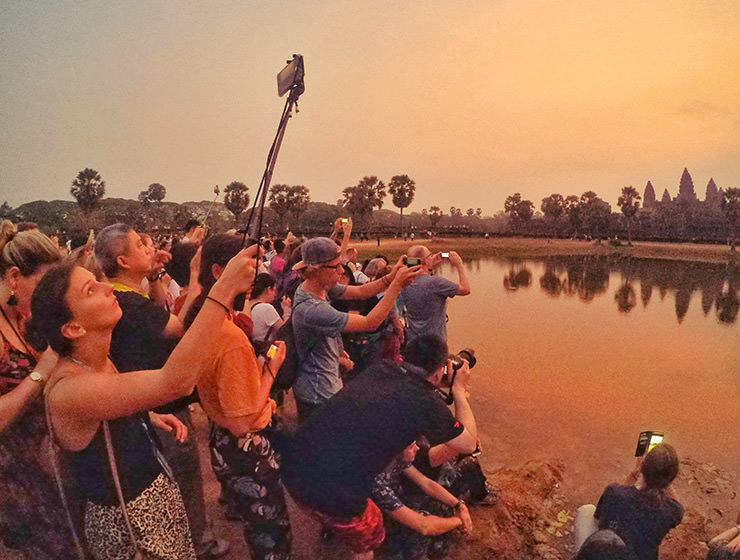

Interesting take on it. I probably would be there jostling for position, if I were there at all, but it does seem a shame to turn it so completely into a photo op.
So many world destinations are becoming just that – photo opportunities! It feels as if nobody is traveling anymore before the images get posted on social media!
I experienced the same thing you did, everyone waiting for that perfect photo. When I was there at the same point, I thought, “while everyone is taking the photo, I am going to go to the top of the wat and just watch the sunrise.” And I. did just that. Watched in peace while the throngs of tourists left me have the place to myself.
Such a great strategy, John! One to learn from!
Jeeze – who would have thought of that! I mean, like, if you don’t capture and appropriate it like, for yourself as an image, how do you ever enjoy it? Such a great Zen approach, like, just experience the moment as it is. Wow, I can’t wait to try that. Sooo insightful. Thanks, Man.
I’m glad you liked the article, Ferdinand!
Well, at the moment there are just a couple of hundred visitors to Angkor temples per month due to the pandemic, so craziness is officially gone. No need to elbow anyone to get the shot 🙂
Or to enjoy it zen-mode, as you proposed!
Lucky those who can visit otherwise popular sites in these times of no travel!